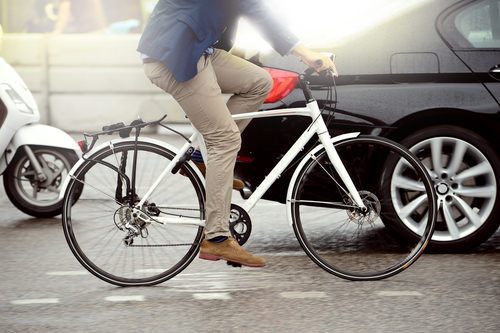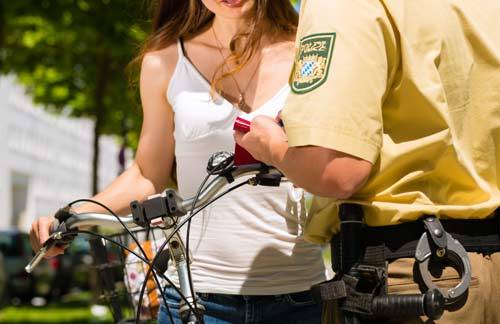Vehicle Code 21200 CVC is the California bicycle law that imposes on bike riders the same duties and responsibilities as motor vehicle drivers. For example, bicyclists must perform such acts as:
- follow traffic signals,
- obey speed limits,
- stop at stop signs, and
- bike on the right-hand side of the road.
The language of the code section reads as follows:
21200 CVS. (a) (1) A person riding a bicycle or operating a pedicab upon a highway has all the rights and is subject to all the provisions applicable to the driver of a vehicle by this division, including, but not limited to, provisions concerning driving under the influence of alcoholic beverages or drugs, and by Division 10 (commencing with Section 20000), Section 27400, Division 16.7 (commencing with Section 39000), Division 17 (commencing with Section 40000.1), and Division 18 (commencing with Section 42000), except those provisions which by their very nature can have no application.
(2) A person operating a bicycle on a Class I bikeway, as defined in subdivision (a) of Section 890.4 of the Streets and Highways Code, has all the rights and is subject to all the provisions applicable to the driver of a vehicle pursuant to Section 20001, except those provisions which by their very nature can have no application.
(b) (1) A peace officer, as defined in Chapter 4.5 (commencing with Section 830) of Title 3 of Part 2 of the Penal Code, operating a bicycle during the course of his or her duties is exempt from the requirements of subdivision (a), except as those requirements relate to driving under the influence of alcoholic beverages or drugs, if the bicycle is being operated under any of the following circumstances:
(A) In response to an emergency call.
(B) While engaged in rescue operations.
(C) In the immediate pursuit of an actual or suspected violator of the law.
(2) This subdivision does not relieve a peace officer from the duty to operate a bicycle with due regard for the safety of all persons using the highway.
Our California auto accident attorneys will highlight the following in this article:
- 1. What VC 21200 Does
- 2. Penalties
- 3. Legal Defenses
- 4. Traffic School
- 5. Criminal Charges
- 6. Ignoring a Ticket
- 7. Cycling Under the Influence
- Additional Resources

California Vehicle Code 21200 VC is the California code section that imposes on bike riders the same duties and responsibilities as motor vehicle drivers.
1. What VC 21200 Does
California Vehicle Code 21200(a) states that bicycle riders have all the rights – and are subject to all the obligations – as vehicle drivers.1
21200(b) CVC also applies to police officers operating a bicycle during their normal course of business. The section exempts these officers from following general vehicle laws if the officer is:
- Responding to an emergency call,
- Engaged in rescue operations, or
- Pursuing an actual or suspected violator of the law.2
2. Penalties
A biker that violates a duty imposed on vehicle drivers will receive a ticket and must pay a corresponding fine. The exact cost of the fine will change depending on which specific vehicle law is violated.3
Persons who violate Vehicle Code 21200 could also receive points on their DMV driving record.4 The result is typically an increase in the person’s insurance rates for several years.
Problems also occur when points accumulate over time. If a person in California receives 4 points in 12 months, 6 points in 24 months, or 8 points in 36 months, the DMV can suspend or revoke their driving privileges.

There are many possible defenses to infraction allegations.
3. Legal Defenses
A bicyclist charged with violating VC 21200 should not automatically plead guilty or admit they were at fault. The person can always challenge a traffic ticket by raising a legal defense. Two common defenses include:
- There was an emergency that forced the bicyclist to disobey the law; and,
- The officer made a mistake.
Please note that no matter the exact defense raised, it has to be supported with credible evidence. The best evidence typically includes:
- Witnesses,
- Photographs, and
- Surveillance video.
4. Traffic School
Bicyclists who violate VC 21200 do not have to attend traffic school. However, a person can choose to go to traffic school provided that:
- The person has a valid driver’s license;
- The offense occurred while the person was driving a noncommercial vehicle; and,
- The ticket is for an infraction that is a moving violation.
If a bicyclist chooses to attend traffic school, they must still pay their fine for violating 21200 CVC.5 However, the person generally should not get any points on their driving record if they complete the school.6
5. Criminal Charges
In general, criminal charges do not get filed if a person violates Vehicle Code 21200 CVC. This is because it is typically not a crime if a bicyclist disobeys a law imposed on vehicle drivers.
Violations are most often infractions under California law. Violators are not subject to incarceration or any other criminal penalties.

Bicyclists cannot ignore a ticket for violating Vehicle Code 21200 VC.
6. Ignoring a Ticket
Upon receiving a traffic ticket in California, the offender is obligated to sign a written promise to appear in court. If the driver willfully fails to appear as promised, they violate Vehicle Code 40508 VC.7
It is not a defense if the driver did not intend to break the law.8 It also does not matter whether the offending driver is guilty or innocent of the underlying traffic citation.9 They violate Vehicle Code 40508 just by breaking a promise to:
- Appear in court,
- Appear to pay bail,
- Pay bail in installments,
- Pay a fine within the time authorized, or
- Comply with any condition of the court.10
Violation of Vehicle Code 40508 VC is a misdemeanor. The penalties are:
- Up to six months in county jail, and/or
- A fine of up to $1,000.11
7. Cycling Under the Influence
Many people are unaware that cycling or bicycling under the influence (CUI) in California is against the law.12
In order to show that a biker violated VC 21200.5, the prosecution must prove three facts (known as “elements” of the crime) beyond a reasonable doubt. These are:
- The accused was riding a bicycle;
- The accused was riding the bicycle on a highway; and,
- While riding the bike, the accused was under the influence of alcohol, drugs, or both.13
The punishment for a CUI is a fine of not more than $250 and no jail time.14 3 Further, if a biker is under 21-years-old, a CUI conviction can result in a suspension of their driver’s license.15
Although the punishment for a CUI is less burdensome than California’s DUI penalties, a CUI is still a misdemeanor and will show up as a conviction (a criminal record).16
Additional Resources
For bicycle safety tips, refer to the following:
- National Highway Traffic Safety Administration – a federal agency responsible for vehicle safety standards and reducing traffic-related injuries and fatalities.
- Go Safely California – a traffic safety campaign by the California Office of Traffic Safety aimed at promoting safe driving habits.
- CalBike – the California Bicycle Coalition, an advocacy group working to promote bicycling for healthier, safer, and more sustainable communities in California.
- Visit California – the state’s official tourism organization, dedicated to promoting California as a travel destination.
- California DMV – the California Department of Motor Vehicles, which handles vehicle registration, driver licensing, and related services for the state.
Legal References:
- California vehicle code 21200 (a) VC. AB 1909 (2023).
- California Vehicle Code 21200 (b)(1) VC. See also California Vehicle Code 21200 (b)(1)(A)-(b)(1)(C).
- See same.
- See same.
- See California Courts website.
- See same.
- California Vehicle Code 40508 VC.
- CALCRIM 2240, endnote 1: Someone commits an act willfully when he or she does it willingly or on purpose. It is not required that he or she intend to break the law, hurt someone else, or gain any advantage.
- See same.
- California Vehicle Code 40508 VC, endnote 1.
- California Penal Code 19 PC. Except in cases where a different punishment is prescribed by any law of this state, every offense declared to be a misdemeanor is punishable by imprisonment in the county jail not exceeding six months, or by fine not exceeding one thousand dollars ($1,000), or by both.
- California Vehicle Code 21200 (a) VC.
- California Vehicle Code 21200.5 VC.
- See same.
- California Vehicle Code 13202.5 VC.
- California Vehicle Code 40000.13 VC.
